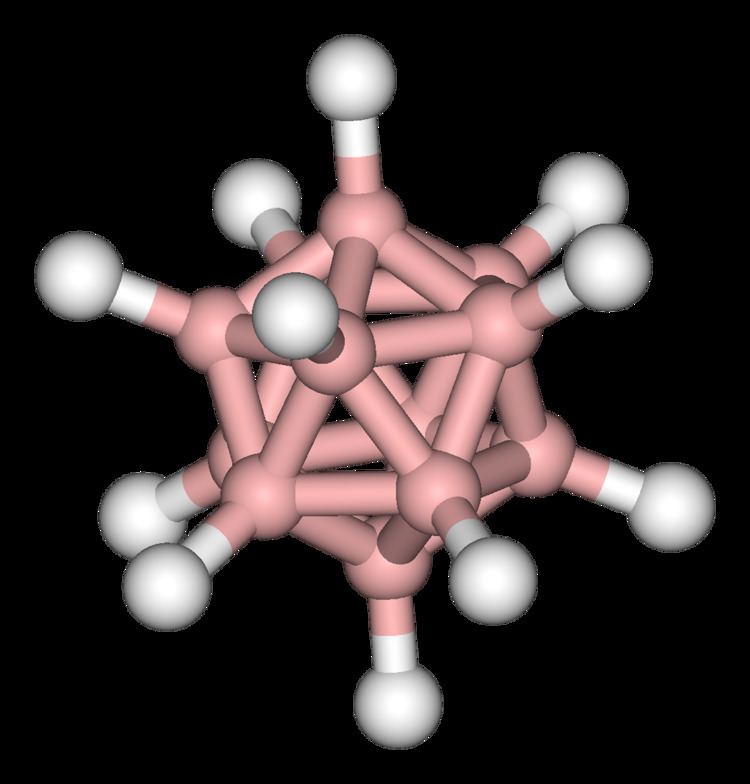 | ||
Dodecaborate (or closo-dodecaborate, or dodecahydro-closo-dodecaborate) is an ionic molecule containing a symmetrical cluster of boron and hydrogen atoms with the molecular formula B12H2−
12. Formally it can be derived from a hypothetical borane called dodecaborane B12H14. It is isoelectronic in structure with the dicarborane with formula B10C2H12.
Contents
Structure
The [B12H12]2− anion's B12 core is a regular icosahedron. The [B12H12]2− as a whole also has icosahedral molecular symmetry, and it belongs to the molecular point group Ih. Its icosahedral shape is consistent with the classification of this cage as "closo" in polyhedral skeletal electron pair theory. (B12H14 - 2H+ → (B12H2−
12.)
The molecular weight = 143.6 g/mol and pKa = 28.
History
The dodecaborate anion was first predicted to exist by H. C. Longuet-Higgins and M. de V. Roberts in 1955. They predicted that only the dianion would be stable. Hawthorne and Pitochelli first made it in 1960, but only with a yield of 4%. Later other synthesis techniques found had yields up to 90%.
Synthesis
The dodecaborate anion was first prepared in modest yield by Pitochelli and Hawthorne from iododecarborane by refluxing it with triethylamine in benzene. It is more conveniently prepared in two steps from sodium borohydride. First the borohydride is converted into a triborate anion using the etherate of boron trifluoride:
4 NaBH4 + BF3 → NaB3H8 + 3 NaF + 4 H2Pyrolysis of the triborate gives the twelve boron cluster as the sodium salt.
Pyrolysis of the triborate compounds of different anions produces various different hydroborate compounds with different results for different metals and temperatures. Other cations include [B10H10]2−, [B9H9]2− and [B11H14]−. The metals and organic ions that can be pyrolised in this way include sodium, potassium, rubidium, cesium, magnesium, calcium, strontium, tetramethyammonium, tetraethyammonium, tetrapropyammonium, and tetrabutyammonium ions.
Another high yield method heats triethylamine borane with diborane at a temperature of 180 °C. Yet another heats pentaborane at 125° with the same triethylamine borane. In both cases the dodecaborate salt of trimethylamine is produced.
The cheapest synthesis route involves a potassium tetrafluoroborate reaction with calcium hydride.
Heating boron trichloride with hydrogen and sodium hydride also makes closo-dodecaborate, but also produces chlorine derivatives that cannot easily be separated.
Salts
Lithium, sodium, potassium, rubidium, cesium, copper(i), silver, thallium(i), beryllium, magnesium, calcium, strontium, barium, zinc, cadmium, aluminium, scandium, yttrium, numerous rare earth metals, zirconium, hafnium, uranium, ammonium, tetramethyammonium, tetraethyammonium, tetrapropyammonium, tetrabutyammonium, triethylammonium (pictured), (and other amines) guanidinium, tetraphenylphosphonium and trimethylsulfonium salts have all been made. Mixed salts with chloride, bromide and iodide also exist. Large cations can also form mixed nitrates and hydroborates.
Stability
Dodecaborate is quite stable, surviving hot aqueous sodium hydroxide as well as hydrochloric acid. It rarely forms a ligand in an inner sphere position, but has been found to do so with some compounds of mercury, ruthenium or copper.
It can be electrochemically oxidised to [B24H23]3−.
Substituted derivatives
The hydrogen atoms can be substituted by the halogens to form various isomers depending on the degree of substitution of the hydrogen with halogens. To label the products the boron atoms are numbered. The first boron atom is numbered 1, then the closest ring of five atoms around it is numbered anticlockwise from 2 to 6. The next ring of boron atoms is started from 7 for the atoms closest to number 2 and 3, and counts anticlockwise to 11. The atom opposite the original is numbered 12. The icosahedron of boron atoms is aromatic in nature, and substituents can cause more reactivity at other positions which can be called the ortho, meta or para positions.
Salts of B12H2−
12 undergo hydroxylation with hydrogen peroxide to give [B12(OH)12]2−. A related derivative is B12(CH3)2−
12. This closo boron hydride resists degradation more so than the isoelectronic carboranes.
Fluorine is a deactivating meta direction substituent. Halogens can react directly, or from a dihalomethane, or from hydrogen fluoride. The degree of replacement of hydrogen depends on temperature and acidity. The perhalo ions form strong acids in water.
Under kilobar pressure carbon monoxide [B12H12]2− reacts to form the carbonyl derivatives [B12H11CO]− and the 1,12- and 1,7-isomers of B12H10(CO)2. The para disubstitution at the 1,12 is unusual. In water the dicarbonyls appear to form carboxylic ions: [B12H10(CO)CO2H]− and [B12H10(CO2H)2]2−.
The distribution of water around the dodecaborate anion [B12 clusters depends on the substituents on boron. The anion [B12H2−
12] has a negatively charged outer shell due to hydrogen's greater electronegativity. This negative shell attract the protic termini of water. With substituents like [B12H11NH−
3], the charge distribution is more positive on the top hydrogens near nitrogen and more negative on the lower hydrogens. As a result of this, the water shell around the molecule is arranged in layers of corresponding charges.
Potential applications
Although derivatives of [B12H12]2− have not found any practical or commercial applications, the unusual nature of this dianion has attracted repeated investigations.
Purification of radionuclides
[B12H12]2− salts have been evaluated as counterions for solvent extraction of the radionuclides 152Eu and 241Am, which are cationic trivalent.
Drug delivery
[B12H12]2− and its dodecahydroxyl derivative [B12(OH)12]2− and its methoxy derivative show promise for use in drug delivery. They form "closomers,"
which have been used to make nontargeted high-performance MRI contract agents. These agents are persistent in tumor tissue.
Boron neutron capture therapy
Salts of [B12H12]2− are potential therapeutic agents in cancer treatment. For applications in boron neutron capture therapy (BNCT), derivatives of closo-dodecaborate increase the specificity of neutron irradiation treatment. Neutron irradiation converts nonradioactive dodecaborate containing 10B to radioactive 11B, which upon radioactive decay emits an alpha particle near the tumor.
